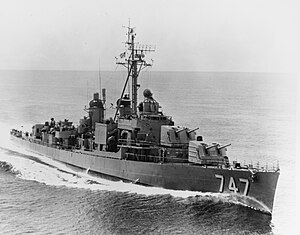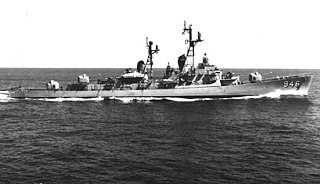
USS Edson (DD-946) is a Forrest Sherman-class destroyer, formerly of the United States Navy, built by Bath Iron Works in Maine in 1958. Her home port was Long Beach, California and she initially served in the Western Pacific/Far East, operating particularly in the Taiwan Strait and off the coast of Vietnam. Her exceptionally meritorious service in 1964 in the Gulf of Tonkin was recognized with the first of three Navy Unit Commendations. During the following years she was shelled by North Vietnamese land forces, and apparently received friendly fire from the US Air Force.

USS Richard S. Edwards (DD-950), named for Admiral Richard Stanislaus Edwards USN (1885–1956), was a Forrest Sherman-class destroyer built by the Puget Sound Bridge and Dredging Company at Seattle, Washington and launched on 24 September 1957 by Mrs. W. B. Franke; and commissioned 5 February 1959.

USS Maddox (DD-731), was an Allen M. Sumner-class destroyer. It was named after Captain William A. T. Maddox of the United States Marine Corps.

USS Duncan (DD-874) was a Gearing-class destroyer of the United States Navy, the third named for Captain Silas Duncan USN (1788–1834). The ship was laid down by the Consolidated Steel Corporation at Orange, Texas on 22 May 1944, launched on 27 October 1944 by Mrs. D. C. Thayer and commissioned on 25 February 1945. The ship was sunk in 1980.

The second USS Henry W. Tucker (DD-875) was a Gearing-class destroyer of the United States Navy.
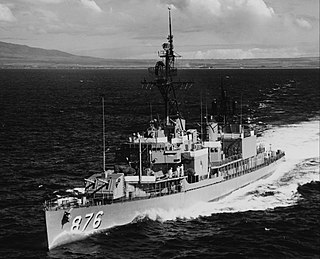
USS Rogers (DD-876) was a Gearing-class destroyer of the United States Navy. She was named for three brothers — Jack Ellis Rogers Jr., Charles Ethbert Rogers, and Edward Keith Rogers — killed in action aboard USS New Orleans during the Battle of Tassafaronga in the Solomon Islands on 30 November 1942.

USS Higbee (DD/DDR-806) was a Gearing-class destroyer in the United States Navy during World War II. She was the first U.S. warship named for a female member of the U.S. Navy, being named for Chief Nurse Lenah S. Higbee (1874–1941), a pioneering Navy nurse who served as Superintendent of the U.S. Navy Nurse Corps during World War I.

USS Collett (DD-730) was a World War II-era Allen M. Sumner-class destroyer in the service of the United States Navy.

USS Agerholm (DD-826) was a Gearing-class destroyer of the United States Navy. She was the only ship named for Harold Crist Agerholm, a Private First Class (Pfc.) in the 2nd Marine Division of the United States Marine Corps. He was killed during the assault on Saipan, and posthumously awarded the Medal of Honor.

USS Ingraham (DD-694) was a United States Navy Allen M. Sumner-class destroyer, the third ship in U.S. Navy history to be named for Duncan Ingraham. She was in commission from 1944 to 1971. Following her US service, she was sold to the Hellenic Navy and renamed Miaoulis. The ship was sunk as a target in 2001.

USS English (DD-696) was an Allen M. Sumner-class destroyer. She was named for Rear Admiral Robert Henry English, a submariner who commanded the light cruiser Helena and had been awarded the Navy Cross and the Navy Distinguished Service Medal. English died in the crash of Pan Am Flight 1104 on 21 January 1943.

USS O'Brien (DD-725), an Allen M. Sumner-class destroyer, was the fourth ship of the United States Navy to be named after Captain Jeremiah O'Brien and his five brothers, Gideon, John, William, Dennis and Joseph, who captured HMS Margaretta on 12 June 1775 during the American Revolution.

USS Harry E. Hubbard (DD-748), was an Allen M. Sumner-class destroyer of the United States Navy.

USS John A. Bole (DD-755), was an Allen M. Sumner-class destroyer of the United States Navy.

USS John W. Thomason (DD-760), an Allen M. Sumner-class destroyer, is the only ship of the United States Navy to be named for John William Thomason, Jr., a USMC officer who was awarded the Navy Cross for bravery during World War I.

USS Southerland (DD-743), a Gearing-class destroyer, was the only ship of the United States Navy to be named for William Henry Hudson Southerland, an admiral.

USS McKean (DD-784) was a Gearing-class destroyer of the United States Navy built by the Todd Pacific Ship Building Company in Seattle, Washington state.

USS Gurke (DD-783) was a Gearing-class destroyer of the United States Navy, in service from 1945 to 1976. She was transferred to Greece in 1977 and served as Tombazis until 1997.
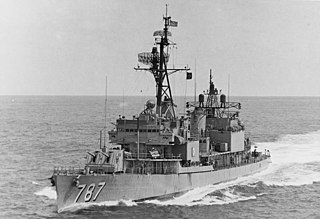
USS James E. Kyes (DD-787) was a Gearing-class destroyer of the United States Navy, named for Commander James E. Kyes (1906–1943).
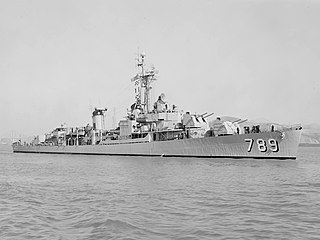
USS Eversole (DD-789) was a Gearing-class destroyer of the United States Navy, the second Navy ship named for Lieutenant John T. Eversole (1915–1942), a naval aviator who was killed in the Battle of Midway. She later served in the Turkish navy from 1973 to 1995 as TCG Gayret (D-352) and is now a ship museum.
